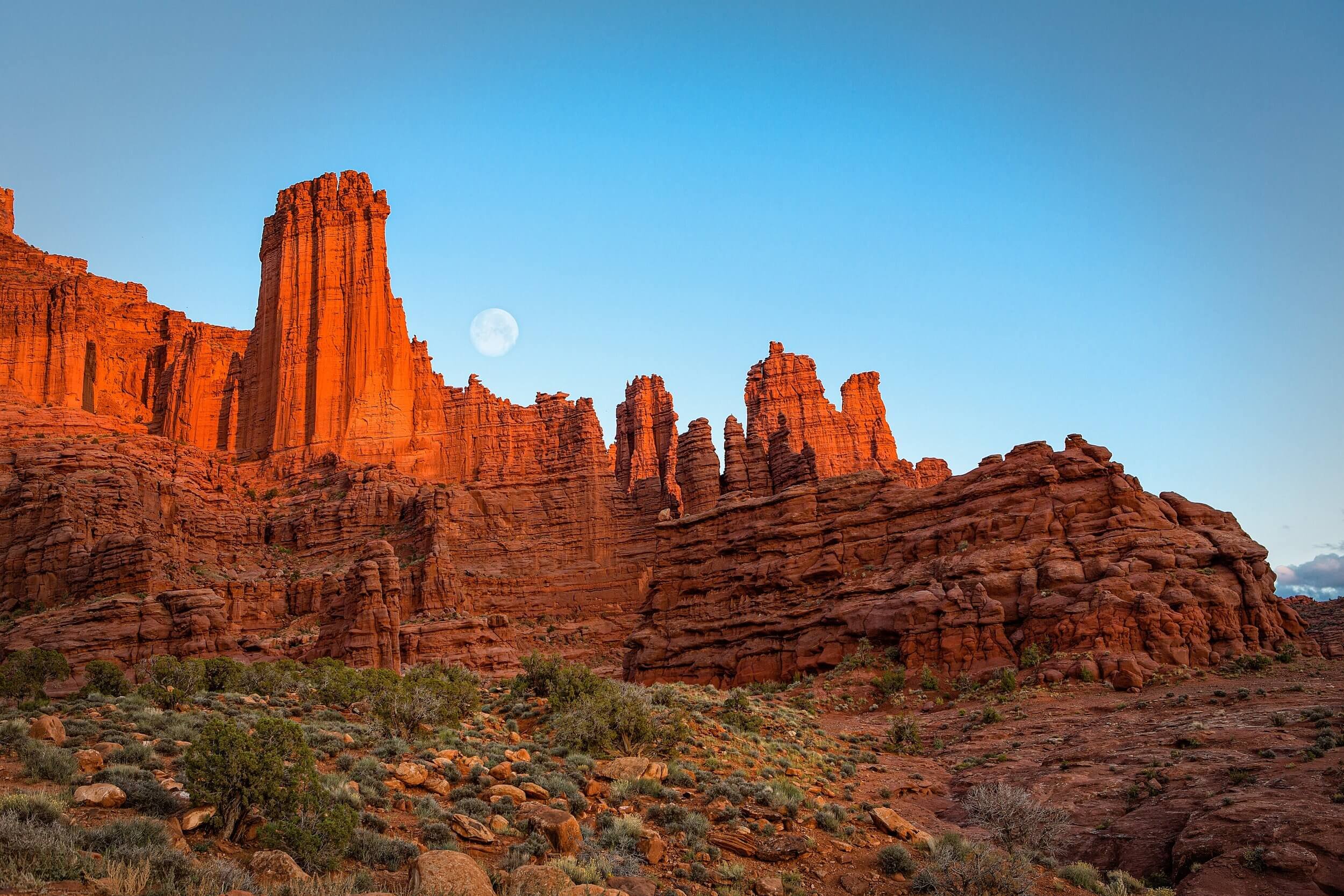
Fisher Towers Rock Climbing
The Fisher Towers are some of the most improbable looking rock climbing routes in the world, with the classic Ancient Art route being a must-do adventure for any rock climber. Located 20 miles from Moab and just down the road from the classic desert towers in Castle Valley, the Fisher Towers are a softer sandstone that resembles a child building castles on the beach by dribbling wet sand. Composed of a Cutler sandstone on the bottom portion and capped by Moenkopi sandstone, these wildly eroded desert towers offer a totally unique style of rock climbing set amongst an incredible setting and big exposure.
Ancient Art
The iconic summit of Ancient Art stands out as a desert tower classic, accessible at a moderate grade of 5.10 (though the two short sections of 5.10 face climbing can be easily bypassed, keeping the route at 5.8). This exposed route ascends several fun pitches of chimneys, cracks and face climbing to a narrow walkway and an absolutely wild finish, a true adventure climb!
There are also several difficult and big wall aid climbing routes in the Fisher Towers for climbers looking for an off-the-beaten-path adventure. Routes such as the Finger of Fate on the Titan are fun, engaging and totally unique once-in-a-lifetime routes for climbers up for the challenge.
Interested in more rock climbing in the Moab area? Check these trips out:
The Moab desert is a fantastic winter escape with the lower elevation and warmer temps. The best seasons for rock climbing are in the spring and fall when temps are most comfortable, it’s possible to chase the sun or shade depending on current conditions.
Ancient Art is the easiest and most popular route in the Fisher Towers. Climbers must be competent 5.8 rock climbers, though no previous multipitch experience is necessary. There are plenty of nearby routes in Moab for more novice climbers.
If flying in, most people will prefer to arrive at Grand Junction Regional or Salt Lake City International Airport. A personal or rental vehicle will be necessary as climbing areas are spread out and remote.
There are plentiful hotels in downtown Moab, conveniently located in walking distance to restaurants. There are also multiple camping options at BLM campgrounds, these can be reserved online at recreation.gov
Climbers are responsible for providing their own personal clothing and equipment. See recommended gear list below:
-
Underwear: Should be comfortable, synthetic fibers wick moisture away from the body
Hiking socks: Lightweight warmth/cushion
Sun hat
Lightweight t-shirt: Merino wool or synthetic fibers will wick sweat away and keep you cooler and more comfortable during hot temps
Midweight fleece jacket: An integrated hood adds warmth and weather protection
Wind jacket: Should have an integrated hood, stretch fabric is often more durable
Hard shell jacket: Lightweight protection for afternoon thunderstorms
Lightweight insulated jacket: Down is lighter and more compressible
Climbing pants or leggings: Lightweight and stretchy
Shorts: Optional, for warmer temps
-
Climbing backpack: Approximately 30+ liters
On-route pack: Approximately 15 liters, optional for longer routes. It is also possible to carry a 25-ish liter pack to the base of the route and then also use it on the route instead of the two pack system
Approach shoes: Should have sticky rubber outsole for security while scrambling on the approach and/or descent, though lightweight hiking shoes are an acceptable substitution
Rock climbing shoes: Comfortable for all day wear
Chalk bag w/ chalk
Belay gloves: Full fingered recommended
Crack gloves: Optional, manufactured tape gloves are more comfortable and provide great base coverage for the best protection while hand jamming
Climbing helmet: Must be UIAA certified
Harness: Must have a belay loop and at least two gear loops
Tubular belay device with round bar stock locking carabiner
Assisted braking device: Your guide can provide a lightweight device to securely belay the leader, but if have a preferred device such as a GriGri, you may bring that
48 inch (120cm) sewn nylon sling. A Personal Anchor System (PAS) may be used instead
2-3 Locking carabiners: Lightweight, screwgate is easier to operate than a triple-action carabiner
1-2 Non locking carabiners
-
Sunglasses: Dimmable recommended, CAT 3 lenses w/ athletic fit
Small tube of sunscreen and SPF chap stick
First aid kit: Small, should include any personal medications
Fully charged phone
Headlamp with fully charged batteries
1-2 liters of water: A soft water bottle is more comfortable in a pack but care needs to be taken to not puncture it
High energy lunch and snacks: A healthy mix of fats, sugar, and protein for a full day of the on-the-go (leftover pizza or sandwiches are a great midday pick-me-up)

Includes:
1 day of guided rock climbing on Ancient Art with an AMGA certified Rock Guide
Group climbing equipment (ropes, rock protection and anchor material)
Does Not Include:
Additional expenses associated with a change in the itinerary
Transportation
Lodging
Meals
Guide gratuity




